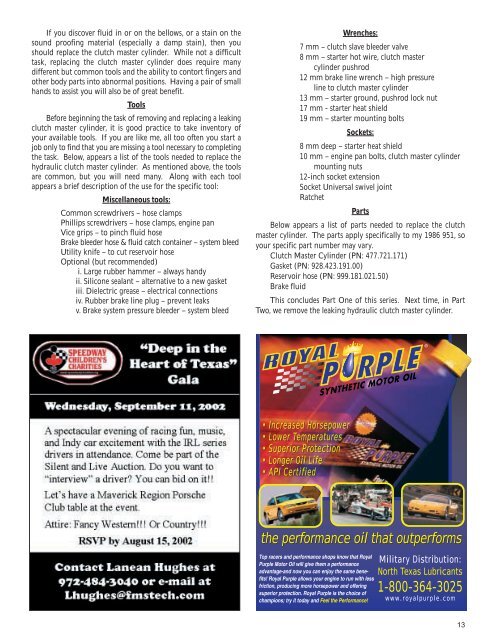Slipstream - August 2002
The monthly newsletter of the Maverick Region of the Porsche Club of America
The monthly newsletter of the Maverick Region of the Porsche Club of America
Create successful ePaper yourself
Turn your PDF publications into a flip-book with our unique Google optimized e-Paper software.
If you discover fluid in or on the bellows, or a stain on the<br />
sound proofing material (especially a damp stain), then you<br />
should replace the clutch master cylinder. While not a difficult<br />
task, replacing the clutch master cylinder does require many<br />
different but common tools and the ability to contort fingers and<br />
other body parts into abnormal positions. Having a pair of small<br />
hands to assist you will also be of great benefit.<br />
Tools<br />
Before beginning the task of removing and replacing a leaking<br />
clutch master cylinder, it is good practice to take inventory of<br />
your available tools. If you are like me, all too often you start a<br />
job only to find that you are missing a tool necessary to completing<br />
the task. Below, appears a list of the tools needed to replace the<br />
hydraulic clutch master cylinder. As mentioned above, the tools<br />
are common, but you will need many. Along with each tool<br />
appears a brief description of the use for the specific tool:<br />
Miscellaneous tools:<br />
Common screwdrivers – hose clamps<br />
Phillips screwdrivers – hose clamps, engine pan<br />
Vice grips – to pinch fluid hose<br />
Brake bleeder hose & fluid catch container – system bleed<br />
Utility knife – to cut reservoir hose<br />
Optional (but recommended)<br />
i. Large rubber hammer – always handy<br />
ii. Silicone sealant – alternative to a new gasket<br />
iii. Dielectric grease – electrical connections<br />
iv. Rubber brake line plug – prevent leaks<br />
v. Brake system pressure bleeder – system bleed<br />
Wrenches:<br />
7 mm – clutch slave bleeder valve<br />
8 mm – starter hot wire, clutch master<br />
cylinder pushrod<br />
12 mm brake line wrench – high pressure<br />
line to clutch master cylinder<br />
13 mm – starter ground, pushrod lock nut<br />
17 mm - starter heat shield<br />
19 mm – starter mounting bolts<br />
Sockets:<br />
8 mm deep – starter heat shield<br />
10 mm – engine pan bolts, clutch master cylinder<br />
mounting nuts<br />
12-inch socket extension<br />
Socket Universal swivel joint<br />
Ratchet<br />
Parts<br />
Below appears a list of parts needed to replace the clutch<br />
master cylinder. The parts apply specifically to my 1986 951, so<br />
your specific part number may vary.<br />
Clutch Master Cylinder (PN: 477.721.171)<br />
Gasket (PN: 928.423.191.00)<br />
Reservoir hose (PN: 999.181.021.50)<br />
Brake fluid<br />
This concludes Part One of this series. Next time, in Part<br />
Two, we remove the leaking hydraulic clutch master cylinder.<br />
• Increased Horsepower<br />
• Lower Temperatures<br />
• Superior Protection<br />
• Longer Oil Life<br />
• API Certified<br />
the performance oil that outperforms<br />
Top racers and performance shops know that Royal<br />
Purple Motor Oil will give them a performance<br />
advantage-and now you can enjoy the same benefits!<br />
Royal Purple allows your engine to run with less<br />
friction, producing more horsepower and offering<br />
superior protection. Royal Purple is the choice of<br />
champions; try it today and Feel the Performance!<br />
Military Distribution:<br />
North Texas Lubricants<br />
1-800-364-3025<br />
www.royalpurple.com<br />
13


















